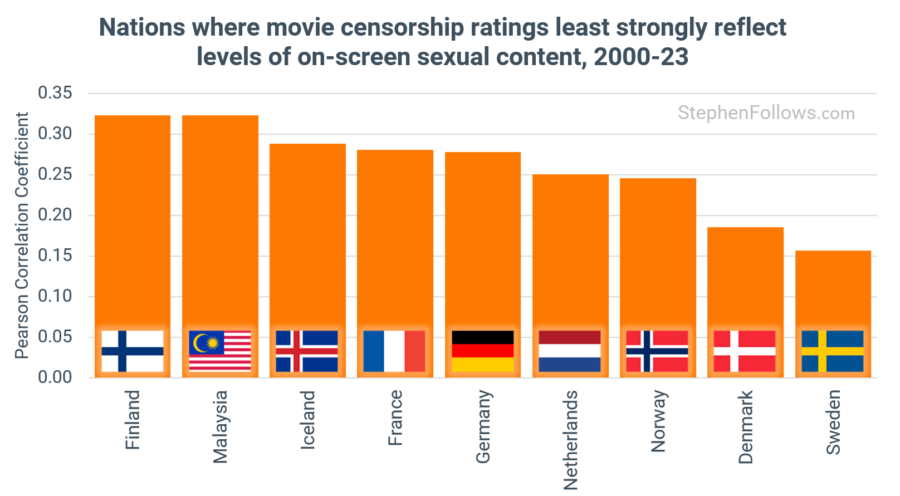Which countries care most about sex in movies?
Sex in movies is a hot topic. Only last month, my research caused a substantial amount of conversation online when I teamed up with The Economist to track the level of sex in movies over the past quarter century. I found that levels of sexual content on the big screen have fallen by 40% since 2000.
Today, I am looking at the extent to which censorship bodies around the world appear to be bothered by levels of sexy stuff in movie theatres (the “sin” in “cinema”, if you will).
I built up a database of almost 6,000 feature films released since 2000 and found the ratings given to each movie in 44 different countries. I then looked at the Pearson correlation between the rating and the levels of sex in each movie. There’s more detail on methods and sources at the end of the article.
For now, it’s enough to know that we’re tracking to what degree the severity of the ratings a movie gets is linked to the amount of sex it contains. If the link was a perfect correlation (i.e. as the amount of sex increases, so too does the censorship rating), then the correlation would be ‘1’. If there was no link at all, it would come out as a ‘0’.
Who cares most about sex?
When examining the data, Japan emerges as the nation most sensitive to sexual content in films. With a Pearson correlation coefficient of 0.59, Japanese censorship bodies appear to be the most consistent in rating films higher when they contain sexual content. This is followed closely by Singapore (0.56) and Hong Kong (0.54).
Interestingly, all four of the top nations are within the East Asian region, which might reflect more conservative cultural values regarding the portrayal of sex in the media.
Which nations care the least about protecting people from sexual content?
On the opposite end of the spectrum, Sweden shows the least correlation between film ratings and sexual content, with a Pearson coefficient of just 0.16. Denmark (0.19) and Norway (0.25) are also low on the list, indicating a more liberal attitude towards sexual content in media.
This aligns with broader views about these countries’ cultural approaches to sexuality and media. In Scandinavia, open discussions about sex and more relaxed attitudes towards sexual media content are more commonplace, which might explain the lighter touch from their censorship bodies in this respect.
Around the world in 44 censorship bodies
Digging deeper, a compelling global pattern emerges, in which countries with similar cultural and historical backgrounds often display similar sensitivities towards sexual content.
Canada (0.52) and the United States (0.44) both show relatively high correlations, likely reflecting shared cultural values and possibly even influenced by similar legal and societal standards.
European countries present a mixed picture. While Ireland (0.53) and the United Kingdom (0.44) demonstrate a significant correlation, other nations like France (0.28) and Germany (0.28) show much weaker links. Eastern European nations such as Lithuania (0.46) and Poland (0.33) fall somewhere in the middle.
Asian countries, meanwhile, show high sensitivity, likely influenced by cultural norms that value modesty and have stricter social conventions regarding explicit content.
African and Latin American countries also vary. South Africa (0.45) shows a moderate correlation, while Latin American countries like Mexico (0.51) and Colombia (0.44) also have significant but less pronounced correlations.
Notes
Today’s research examined 5,918 feature films released between 2000 and 2023. I collected ratings for each film from 44 different countries, ensuring that each country had at least 1,000 ratings in the dataset.
Next, I assigned a value to each rating, with the most open rating (typically “Universal” or “General”) getting a one and increasing as the ratings got stronger (for example, in the UK, an 18 certificate equated to a value of five). This then allowed me to calculate the Pearson coefficient to measure the correlation between the level of the rating and the amount of sexual content.
The raw data from various sources, including each of the censorship bodies, OMDb, IMDb, Wikipedia, Common Sense Media, Dove.org, MPAA, and BBFC. I used these signals to build my own measures of sexual content in each movie.
It’s worth noting that films may have different versions around the world. The measures of sex I tracked were based on the version released in the UK and US (which rarely differ), whereas in some territories, particular shots or moments may be trimmed or removed. That said, I don’t think it’s a massive problem in this case, as we’re looking at a large number of films and tracking how the two sets of data are correlated. So even if a movie had a particularly explicit moment removed, the overall level of sexual content is still lightly to be high. There are very few cases of films with a huge amount of sex being completely neutered for an international release, and even then, these kinds of rare outliers will not affect the overall result much, if at all.
Epilogue
This was a fun project to do as it really reminded me about how subjective censorship is. The ratings don’t just reflect something about the movies we make and choose to watch but also about the culture in which we live.
The post Which countries care most about sex in movies? appeared first on Stephen Follows.





